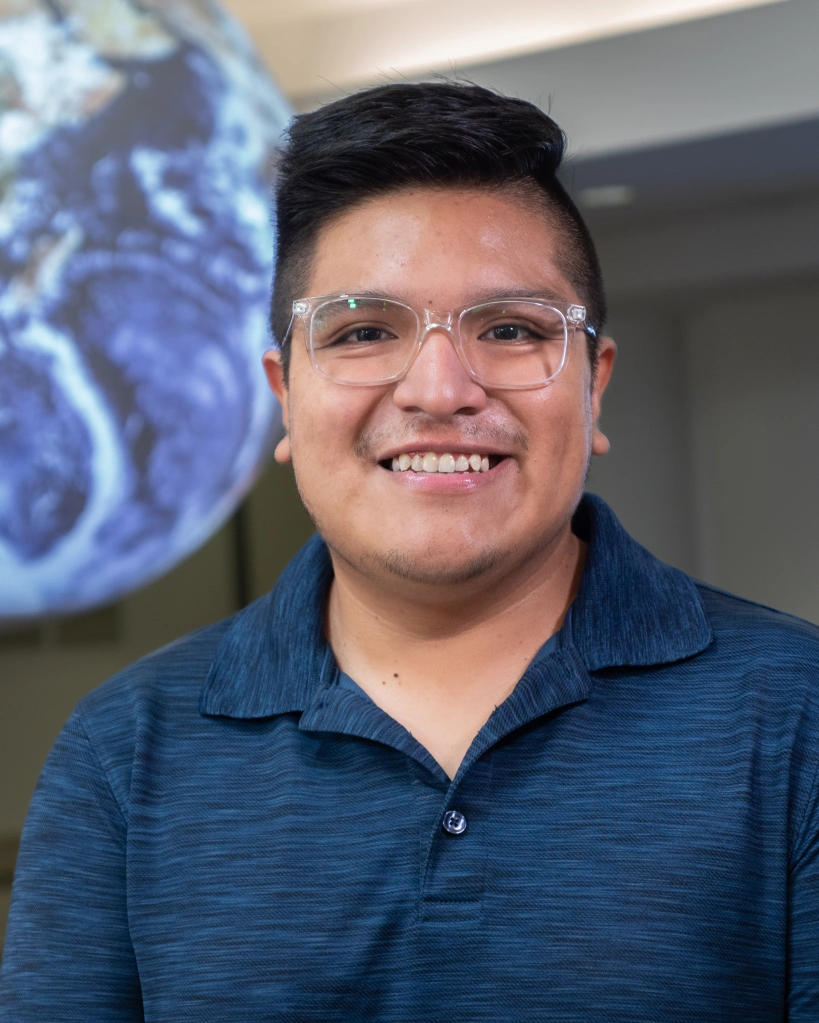GradImpact: How Joseph Trujillo-Falcón is Reshaping Weather Communication for Multilingual Communities
Joseph Trujillo-Falcón’s journey from a bilingual student dreaming of a career in Spanish-language broadcast meteorology to a national expert in risk communication is grounded in his commitment to addressing language inequities in communities.
With a PhD in communication from the University of Oklahoma and an atmospheric science background, Trujillo-Falcón is pioneering how America talks about weather — particularly for the 68.7 million Americans who speak a language other than English at home.
 Trujillo-Falcón was completing his double-major in Spanish and meteorology at Texas A&M University when he had the opportunity to volunteer as a meteorologist at a Spanish-language radio station for a community service requirement. The radio station managers said that he had to have a nickname and that’s how he became “El Cazador de Tormentas,” or Storm Wrangler.
Trujillo-Falcón was completing his double-major in Spanish and meteorology at Texas A&M University when he had the opportunity to volunteer as a meteorologist at a Spanish-language radio station for a community service requirement. The radio station managers said that he had to have a nickname and that’s how he became “El Cazador de Tormentas,” or Storm Wrangler.
“I gave a forecast every single morning: ‘Buenos dias, soy El Cazador de Tormentas,’ and rolled my R’s for 10 seconds,” chuckled Trujillo- Falcón. “It was so corny, but it was the first time I was able to interact with the community directly and it was so much fun. I still look back to those days because it made me the person I am today.”
Though it was when Hurricane Harvey dumped 15 inches of rain on College Station that he had an epiphany about his career as he realized the Spanish-language community was confused by some weather communications.
“They did not understand differences between watch and warning and began panicking,” Trujillo-Falcón said. “That was the moment where I thought, ‘Oh my God,’ we need to do something about this.”
That experience led him to pursue a master’s and PhD in communication at the University of Oklahoma, where he also worked at the National Weather Center. There, he found the perfect environment to merge science and communication — collaborating directly with federal agencies like the National Ocean and Atmospheric Administration (NOAA) and the National Weather Service (NWS) to identify and address deep-rooted language inequities in disaster communication.
His research was centered on how multilingual communities receive, understand and respond to extreme weather and climate events. He talked directly to people that have survived extreme weather hazards like tornadoes and hurricanes.
Using those insights from the field, he then developed nationwide surveys to understand whether these trends are applicable across the rest of the nation. That information provides a snapshot of how the community is responding to different events.
He said using that data, he developed evidence-based practices for agencies like NOAA and the NWS to evolve the risk communication strategies to be centered in social science research.
According to Trujillo-Falcón, fatalities during extreme weather events often stem not from forecast errors, but from miscommunication. “We’ve seen people receive warnings they couldn’t understand — and that’s what led to tragedy,” he said. “If we don’t even have a term to describe a hazard in someone’s language, how can we expect them to respond?”
For example, in Arabic, the same word is often used for both tornado and hurricane — two vastly different threats with different safety measures. In Spanish, regional dialects lead to wildly different translations. One mistranslation of “rip current” as resaca — meaning “hangover” in many parts of Latin America — led to dangerously confused reactions.
“The Weather Service was literally issuing ‘hangover warnings,’” Trujillo-Falcón said. “It sounds funny, but people were going to the beach during a rip current event — exactly what we didn’t want.”
Trujillo-Falcón said this research opened his eyes to how important access to accurate weather information was to multilingual communities.
“I think that’s what we’re missing right now, that cultural competency and making sure that we address weather communications across these language barriers to help people understand weather events.”
While he was working on his PhD, he was fully employed by the NOAA Cooperative Institute. One of his proudest achievements was helping the Storm Prediction Center develop a risk category scale in Spanish that is now used nationwide by major Spanish-language broadcasters. His team conducted a nationwide survey to test different variations of these translations and found ones that everyone could understand. The Storm Prediction Center then made the translations part of their policy.
“We found a dialect-neutral version of the terms and it was the first time the NWS successfully implemented an initiative in Spanish,” he explains. “I think it opened a new chapter in the agency— to really be able to consider everyone in a disaster. Because at the end of the day, that’s all that matters.”
In April, the Associated Press reported that the NWS had paused the translations for its products for non-English speakers. A spokesperson for the NWS said they had to pause the translations because the contract with the translation provider had lapsed.
Trujillo-Falcón explained that in 2023, the NWS contracted with Lilt, an artificial intelligence company to train AI to create multilingual translations. The NWS has been training AI for the past two years, including using Trujillo-Falcón’s research recommendations on dialects, so that it reached 99% accuracy and reduced translation time from one hour to two to three minutes for multiple languages. The contract was renewed last week, and the translations have resumed, but the pause happened on the same day of a big tornado outbreak and many people went without vital weather communications.
“One in five Americans speak another language other than English and 66.5 million tourists visit the U.S. every year,” Trujillo-Falcón said. “I’m glad it was reinstated so we can continue to provide these services for the American people and for tourists that contribute to our economy.”
With recent threats to funding at NOAA, which oversees NWS, there is concern if the services Americans have come to rely on will still be provided. But Trujillo-Falcón remains optimistic because he believes most of us share the same fundamental values.
“I’ve worked with people from both sides of the aisle and we can come from very different walks of life. But people always agree with me that everyone deserves to stay safe during a disaster,” Trujillo-Falcón said. “At the end of the day, the National Weather Service mission statement is to protect life and property, and I think we can all agree with that.”
Now based at the University of Illinois, Trujillo-Falcón is building something new: The ALERTAS Lab — Advancing Language Equity and Resilience in the Atmospheric Sciences. As a newly appointed assistant professor with affiliations in both atmospheric science and communication, he’s leading a growing team of undergraduate, master’s and PhD students researching multilingual risk communication across a wide range of hazards — from hurricanes and floods to wildfires and winter storms.
Their upcoming project will be launching the first national weather survey translated into Spanish, Mandarin, and Vietnamese to test the effectiveness of AI-generated messages. “We want to make sure we’re not issuing ‘hangover warnings’ in those languages, too,” he said with a grin.
His goal is to develop a new generation of weather communicators who think deeply about the people receiving their messages — not just the science behind them.
“I’m not trying to make you a social scientist,” he said he tells his meteorology students. “But next time you issue a forecast, I want you to think about the community.”

